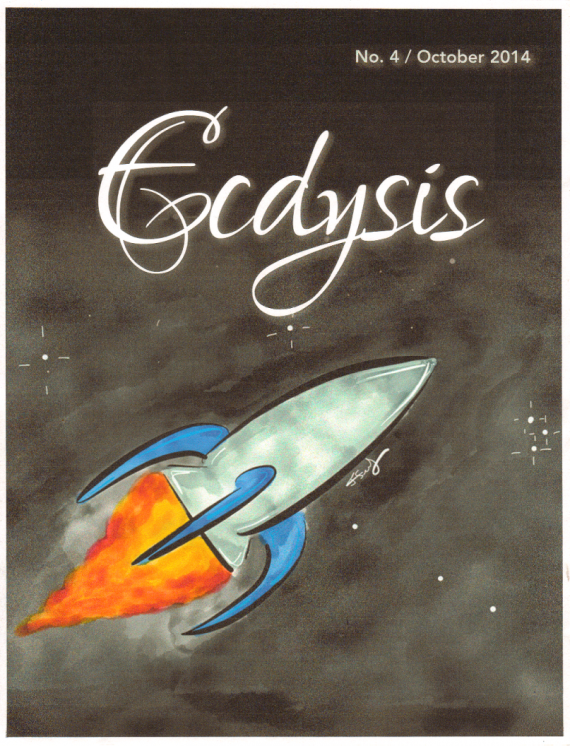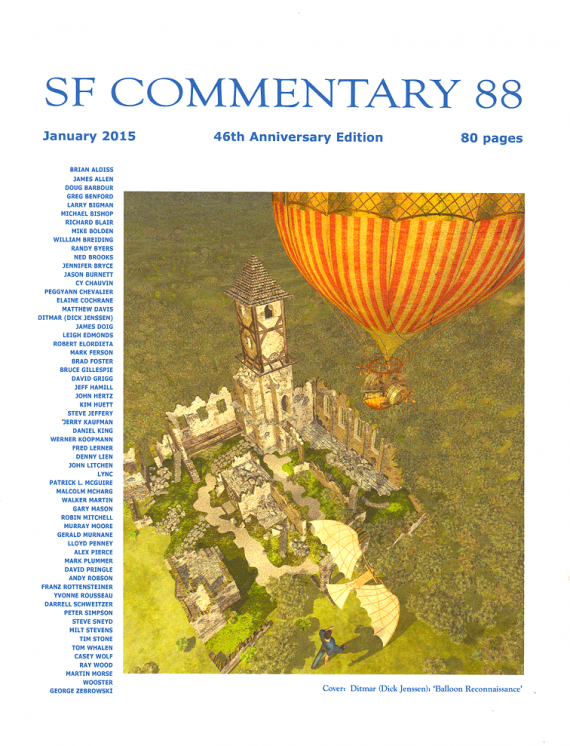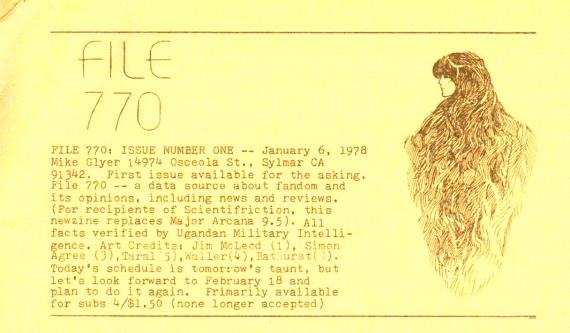Fanzines reviewed: DRINK TANK (#396), ECDYSIS (#4), FILE 770 (#164), SF COMMENTARY (#88), and FILE 770 (#1).
(Please note: Zine reviews are prepared a week or more in advance of publication of this column and may not necessarily include the latest issue available, but the link to multiple issues given at the bottom of each review probably does.)

THE DRINK TANK (#396) – January 2015 – Find it here
Faned: Chris Garcia. American Per/Genzine.
This issue only five pages long, including the cover.
Why review it? I like the cover. I like the editor. I like the zine. Want to draw your attention to all three.
Chris is an exuberant fan, a passionate fan, and his victory dance/collapse on winning a Hugo Award for this zine in 2011 was a sight to behold. Talk about fenthusiasm! We need more fen like him!
Alas, Chris will be shutting down DRINK TANK soon, I’m assuming with issue #400. It’s said the average fanzine lasts six or seven issues. Four hundred issues (starting in 2005) seems like a pretty good run to me. Not too shabby.
Fortunately Chris will carry on with his co-editorship of the British zine JOURNEY PLANET and, remarkably, according to an article devoted to a Janus-like look backward and forward at his fanac, start up at least two new zines, maybe more.
He also writes about his coffee habit, including: “Stupid Coffee Tricks for Americans – First, get a Canadian Friend to send you a bunch of Tim Horton’s Coffee Cups. Next, start leaving them around in waste baskets or other places where they can be seen. One day, leave one on your desk where a co-worker is sure to see it. When they inevitably ask where it came from say ‘They just opened one up in Little Vancouver.’ And when they ask about that say ‘Oh, just look for the toques and you’ll know you’re there.” As a Canadian, I like this.
No letter of comment from Lloyd Penney, or anyone else. Chris publishes several issues of DRINK TANK a month and it is hard for loc writers to keep up.
THE DRINK TANK worth reading? – Even though it’s about to go defunct, the answer is a resounding yes! The entire run, often co-edited by James Bacon, and frequently featuring multiple contributors, is well worth browsing through. All kinds good stuff.
( Multiple issues of The Drink Tank here )

ECDYSIS (#4) – October 2014 – Find it here
Faned: Jonathan Crowe. Canadian Serconzine.
“Sercon” as in serious constructive, meaning a scholarly zine. ECDYSIS is a fanzine aimed at fans of SF&F literature, as opposed to targeting fannish fans of fandom. In effect, a throwback to the early zines of the 1930s.
Is this a good thing? It is if you love SF&F.
For instance, in his editorial Jonathan tackles one of fandom’s eternal (and pointless) debates: “The problem here is a too-narrow definition of genre. Trying to define science fiction and fantasy is a tremendous waste of time that we nevertheless persist in indulging in. ‘This is science fiction; that is really fantasy; and that is actually mainstream and I don’t know why we’re discussing it here.”
He points out that “Fantasy is allowed to be subtle” and “Science Fiction is allowed to be literary.” I agree.
I personally rely on the famous dictum “Science Fiction is what I point at and call science fiction.” Good enough for me. End of debate.
Tamara Vardomskaya attended the 2014 Clarion SF&F writers workshop. Some of the advice she received surprised her (and me). Many writers’ guides stress cutting first drafts to the bone to get rid of all the extraneous stuff. Tamara was advised “You need to expand this… more detail… Let the story breathe…” And as for the ending of one of her stories submitted, an ending everyone including herself hated, an ending which she wrote for the sake of clarity, she was told to “Cut it. Leave it ambiguous. Not everything has to be explained and solved and revealed. Clarity sometimes makes things worse.”
The story in question, “Acrobatic Duality,” was picked up by Tor.com before the workshop had even finished. Tamara’s first professional sale. I believe this answers the age-old question as to whether workshops serve any practical purpose.
Jonathan reviews Karl Schroeder’s novel “LOCKSTEP, and the Problem of Non-FTL Interstellar Civilization.”( FTL = Faster Than Light.) I’m not going to give away the solution, but I agree with Jonathan that Schroeder’s concept is both original and brilliant.
Tamara throws in a couple of reviews, one quite playful, the other deeply analytical. On the lighter side, Jennifer Seeley (who does all the art for ECDYSIS) contributes four sketch/doodles she created on her Ipad while attending authors readings at assorted conventions. A unique pastime I do believe, with delightful results.
The loc column consists of but one letter, sent in by – you guessed it – Lloyd Penney.
ECDYSIS worth reading? – If you are an SF&F fan uninterested in SF&F literature, no. But if you love SF&F literature as I do, absolutely! Borders on semi-pro territory this fanzine does. If that is to your taste, ECDYSIS is a must read.
( Multiple issues of Ecdysis here )

FILE 770 (#164) – December 2014 – Find it here
Faned: Mike Glyer. American Newszine.
FILE 770 has been the leading American fannish newszine for over four decades. Just as no one considered you a legit faned until you received letters of comment from Harry Warner Jr. (Lloyd Penney the modern incarnation), you hadn’t truly passed the bar till you received mention in FILE 770 (or better yet, contributed information or even an article). FILE 770 was, and is, the statement of record for American fandom.
This is the modern age, however, the very expensive (in terms of postage) modern age, and so FILE 770 has been transformed into a frequent, sometimes daily, information blog which you can read here. Well worth checking out, at least weekly I’d say, if not more often.
Nevertheless, for tradition’s sake, Mike publishes a paper/online issue of FILE 770, usually in December, summoning up the year’s events. Consequently this issue features a handy-dandy reference guide to a fair number of American and foreign awards both fannish and pro, though by no means all. Bit surprised not to see Canada’s Aurora Awards listed. On the other hand, good to see reminders of awards less prominent than the Hugos, such as the British SF Association awards and the Tolkein Society Awards. So, overall, a good snapshot of how genre participants are recognized by their peers and fans.
A bit distressing to read a year’s worth of orbituaries. Yet, for newcomers to the genre, a valuable and inspiring insight into the fannish and/or professional careers of the individuals honoured in remembrance.
To pick just one example, Louis Fallert, known to all by his fannish name “Blue Petal,” was involved with “Spiderism, the fannish religion originated by John Kusske, Al Kuhfeld, and Blue Petal. (As you know, Bob, The Great Spider eats peoples’ souls when they die, unless they have bribed one of the priests of the Great Spider.) They provided Minneapans with copies of a trifold brochure with a voracious spider on the front and contents explaining the faith, which they claimed to be handing to evangelists who came to their door.” Ahhh, fandom. I tried to find a link to the pamphlet but couldn’t find it stored anywhere online, alas.
Much news of fannish import, such as the article by John Hertz titled “The Tetrachiliad” in which he describes the 4,000th meeting of the Los Angeles Science Fantasy Society: “The LASFS, my local s-f club, is I’m proud to say the oldest in the world… The meeting hall in our current clubhouse, our third, was crowded. So were the social hall, the computer room, and the library, with members who didn’t care to attend the meeting. Some things never change.”
Throw in con reports (ConQuest, World Fantasy, NASFic, Remembering SF’s 50th Anniversary Family Reunion: Noreason 3, 1989) several amusing articles (including “Mr. Peabody and Sherman” by Taral Wayne), eye-opening examples of fannish politics, and lots of locs (one by Lloyd Penney), and you already know the answer to the following question.
FILE 770 worth reading? – Yes! Both the blog and the annual ish. Best place to get a handle on past and current fandom.
( Multiple issues of File 770 here )

SF COMMENTARY (#88) – January 2015 (46th Anniversary Issue) – Find it here
Faned: Bruce R. Gillespie. Australian Genzine.
Really a Sercon zine. Tends to be filled with detailed studies of this or that fan or pro’s accomplishments. One of my favourite issues is #83 (October 2012) which you can read here. It features an incredible article by Guy Salvidge titled “Discovering Philip K. Dick” which reviews numerous novels by Dick as well as a number of books about him. As P.K. Dick is my favourite SF author, I highly recommend this article to anyone who hasn’t read him as the best possible introduction to his life and work.
The current issue contains the article “Philip K. Dick, alternate-world SF, and I” by Michael Bishop: “Today, I counted the books by Philip K. Dick in our house… It did not surprise me to find that we own nearly 50 distinct works of fiction by this extraordinary writer, far more books than I own by any other writer of any kind of work at all.” This immediately set me scrambling to count the P.K.D. books in MY library. Only 39! Dang! Which ones am I missing? Arrgh!
Following his brief review of Dick’s life and works, Bishop appends his eulogy to Dick, the first part of which reads:
Philip K. Dick is dead, a lass
with dark hair said. Her tears flowed wholesale,
remember? Phil wrote like a relentless dentist,
drilling the pocked enamel of reality to expose
its beautiful decay….”
A surreal eulogy, a tribute to Dick in more ways than one.
You are not a fan of P.K. Dick, you say? Well, there’s also a lengthy study by Patrick L. McGuire on the SF/mystery novels of J.D. Robb (Eleanor Robertson), and a short but wonderful account by Murray Moore about Brian Aldiss appearing at LonCon 3 Worldcon on the occasion of his 89th birthday. Aldiss revealed one of his writing technique secrets: “Living in Oxford, Aldiss, as a writer, took advantage of the proximity of experts: ‘Knock on any cobwebby door and an ancient don will tell you about everything — but sex.”
A number of letters of comment are presented as separate mini-essays in themselves. Some examples: “There’s still room for hard SF” by Greg Benford, “Moving among the genres” by Doug Barbour, “Ray Bradbury and the pulps” by Darrell Schweitzer, and “Word Radio” by Casey Wolf. This is why SF Commentary is one of the “grand old men” of fanzines, so much so that it attracts seasoned professionals and legendary fans as contributors. A revered and respected fanzine.
There are over 40 locs to read (including one by Lloyd Penney). Even the WAHF (we also heard from) column has about 30 names, each with a brief quote. Many faneds bemoan the lack of locs these days. Certainly not a problem for THIS zine!
SF COMMENTARY worth reading? – If you are a serious fan of SF&F literature, definitely. And if, like me, reading locs is one of your guilty pleasures, likewise. Faned Bruce R. Gillespie has done a terrific job over the years. A great zine.
( Multiple issues of SF Commentary here )
AND FROM THE VAULTS:

FILE 770 (#1) – January 1978 – Find it here
Faned: Mike Glyer. American Newszine.
Ah, the very first issue of FILE 770. Yet not a true beginning. Prior to FILE 770 Mike Glyer published his perzine SCIENTIFRICTION from about 1974 on. I believe it contained the occasional piece of fannish news. In FILE 770 Mike made a fresh start with a zine wholly devoted to the subject. He carried on with SCIENTIFRICTION for a while however. The last issue I’m aware of, #12, came out in 1983.
Why FILE 770? File 13 is the proverbial wastebasket. Whereas FILE 770 refers to the famous all-night-long party in room 770 at the St. Charles Hotel during the 1951 Worldcon in New Orleans which quickly assumed mythic proportions in fannish lore. To quote Harry Warner Jr., “Room 770 became more famous than all the rest of the convention put together.” Mike’s choice of title clearly implies his newszine collects everything you need to know about fandom in an ongoing, joyous celebration of same. The title alone is excellent PR for the zine, at least to all who understand what is referenced. Brilliant title, in fact.
Of particular interest to me (you’ll see why in a moment) is Mike’s editorial essay “The Pied Typer” where he writes: “Fanzine reviewing belongs with those things everybody talks about but nobody does anything about. The art only thrives in England because they treat it as a tournament in insults, and it is moribund in America… the fans best equipped to perform the job seem bored with it…”
He lays out the minimum skills required of a reviewer: “Good fanzine reviews are written by fans with extensive publishing experience and some understanding of production values, who know the art of the possible (rather than absurdly comparing everything to HYPHEN, ALGOL and ENERGUMEN). Good fanzine reviewers interact with the contents, requiring the writer to express himself – not just pass judgement. And it should go without saying that good fanzine reviews accurately inform one how to acquire a mentioned zine by repeating what the editor set down in his colophon.”
Let’s see how I fare.
1) – “extensive publishing experience” = couple of hundred issues of assorted clubzines, newszines, perzines, genzines and apazines over 40 odd years. Acceptable?
2) – “some understanding of production values” = emphasis on “some,” but I do appreciate layout skill exhibited by others. Good enough?
3) – “art of the possible” = I refuse to compare everything to the best zines. I prefer to point out the best within each zine. Sensible?
4) – “interact with contents… express himself” = Some might say too much. I don’t care. Or rather, I DO care.
5) – “not pass judgement” = I’ll tell you what I like and leave it at that. Is okay?
6) – “how to acquire” = Thank Ghu so easy nowadays. I post links where I can.
7) – Final point. In 1994 Mike Glyer wrote “BCSFAzine is the best clubzine in the world.” (I’d been editor since 1989.) I promptly quoted him on the cover of issue #250. Not only that, but I’m humble too.
Thing is, I hope Mike approves of what I’m doing in this column. Same thing he does with FILE 770, really. Celebrating fandom.
FILE 770 #1 worth reading? – Yep, lots of nifty stuff I didn’t have space to mention.
Multiple issues of File 770 here
BY THE WAY:
You can find a fantastic collection of zines at: Efanzines
You can find a quite good selection of Canadian zines at: Canadian SF Fanzine Archive










